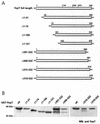The C terminus of YopT is crucial for activity and the N terminus is crucial for substrate binding
- PMID: 12874342
- PMCID: PMC166019
- DOI: 10.1128/IAI.71.8.4623-4632.2003
The C terminus of YopT is crucial for activity and the N terminus is crucial for substrate binding
Abstract
Recently, it was shown that Yersinia outer protein T (YopT) belongs to a new family of cysteine proteases containing invariant C, H, and D residues that are crucial for its activity. YopT cleaves RhoA, Rac, and Cdc42 at their C termini, thereby releasing them from the membrane. Moreover, YopT inhibits the Rho-rhotekin and Rho-guanine nucleotide dissociation inhibitor interactions. To characterize the active domain of YopT, we constructed N- and C-terminal truncations and expressed them as glutathione S-transferase fusion proteins in Escherichia coli. The toxin fragments were tested for stability by trypsin digestion. The activity of the proteins was studied by membrane release assay, rhotekin pulldown experiments, and microinjection. Whereas deletion of the first 74 N-terminal amino acids did not influence the activity of YopT, deletion of 8 amino acids from the C terminus led to complete loss of activity. N-terminal deletion of 100 amino acids led to an inactive protein, although it still contained the amino acids C139, H258, and D274, which are essential for catalysis. Loss of activity of the N-terminal deletions corresponded to the block of interaction with RhoA, indicating that residues 75 to 100 of YopT are essential for binding to the GTPase. By contrast, when up to 15 amino acids of the C terminus were deleted, the protein had no activity but was still able to interact with RhoA, suggesting a role for the C terminus in the enzyme activity of YopT.
Figures







Similar articles
-
Recombinant Yersinia YopT leads to uncoupling of RhoA-effector interaction.Infect Immun. 2001 Dec;69(12):7535-43. doi: 10.1128/IAI.69.12.7535-7543.2001. Infect Immun. 2001. PMID: 11705930 Free PMC article.
-
Characterization of YopT effects on Rho GTPases in Yersinia enterocolitica-infected cells.J Biol Chem. 2003 Aug 29;278(35):33217-23. doi: 10.1074/jbc.M303349200. Epub 2003 Jun 5. J Biol Chem. 2003. PMID: 12791693
-
Biochemical characterization of the Yersinia YopT protease: cleavage site and recognition elements in Rho GTPases.Proc Natl Acad Sci U S A. 2003 Feb 4;100(3):904-9. doi: 10.1073/pnas.252770599. Epub 2003 Jan 21. Proc Natl Acad Sci U S A. 2003. PMID: 12538863 Free PMC article.
-
Modulation of Rho GTPases and the actin cytoskeleton by YopT of Yersinia.Curr Top Microbiol Immunol. 2005;291:167-75. doi: 10.1007/3-540-27511-8_9. Curr Top Microbiol Immunol. 2005. PMID: 15981463 Review.
-
Yersinia enterocolitica outer protein T (YopT).Eur J Cell Biol. 2011 Nov;90(11):955-8. doi: 10.1016/j.ejcb.2010.12.005. Epub 2011 Jan 20. Eur J Cell Biol. 2011. PMID: 21255864 Review.
Cited by
-
Endoproteolytic processing of RhoA by Rce1 is required for the cleavage of RhoA by Yersinia enterocolitica outer protein T.Infect Immun. 2006 Mar;74(3):1712-7. doi: 10.1128/IAI.74.3.1712-1717.2006. Infect Immun. 2006. PMID: 16495543 Free PMC article.
-
Crystal structure of Yersinia enterocolitica type III secretion chaperone SycT.Protein Sci. 2005 Aug;14(8):1993-2002. doi: 10.1110/ps.051474605. Protein Sci. 2005. PMID: 16046625 Free PMC article.
-
Engineering Photorhabdus luminescens toxin complex (PTC) into a recombinant injection nanomachine.Life Sci Alliance. 2019 Sep 20;2(5):e201900485. doi: 10.26508/lsa.201900485. Print 2019 Oct. Life Sci Alliance. 2019. PMID: 31540947 Free PMC article.
-
Two distinct functions of ComW in stabilization and activation of the alternative sigma factor ComX in Streptococcus pneumoniae.J Bacteriol. 2005 May;187(9):3052-61. doi: 10.1128/JB.187.9.3052-3061.2005. J Bacteriol. 2005. PMID: 15838032 Free PMC article.
-
Translocated effectors of Yersinia.Curr Opin Microbiol. 2009 Feb;12(1):94-100. doi: 10.1016/j.mib.2008.12.005. Curr Opin Microbiol. 2009. PMID: 19185531 Free PMC article. Review.
References
-
- Aktories, K., G. Schmidt, and F. Hofmann. 2000. GTPases targeted by bacterial toxins, p. 311-331. In A. Hall (ed.), GTPases. Oxford University Press, Oxford, England.
-
- Barz, C., T. N. Abahji, K. Trülzsch, and J. Heesemann. 2000. The Yersinia Ser/Thr protein kinase YpkA/YopO directly interacts with the small GTPases RhoA and Rac-1. FEBS Lett. 482:139-143. - PubMed
Publication types
MeSH terms
Substances
LinkOut - more resources
Full Text Sources
Miscellaneous

